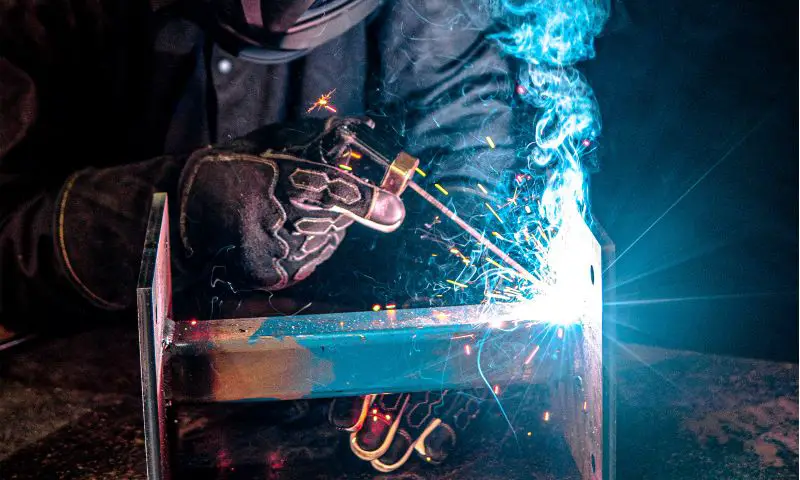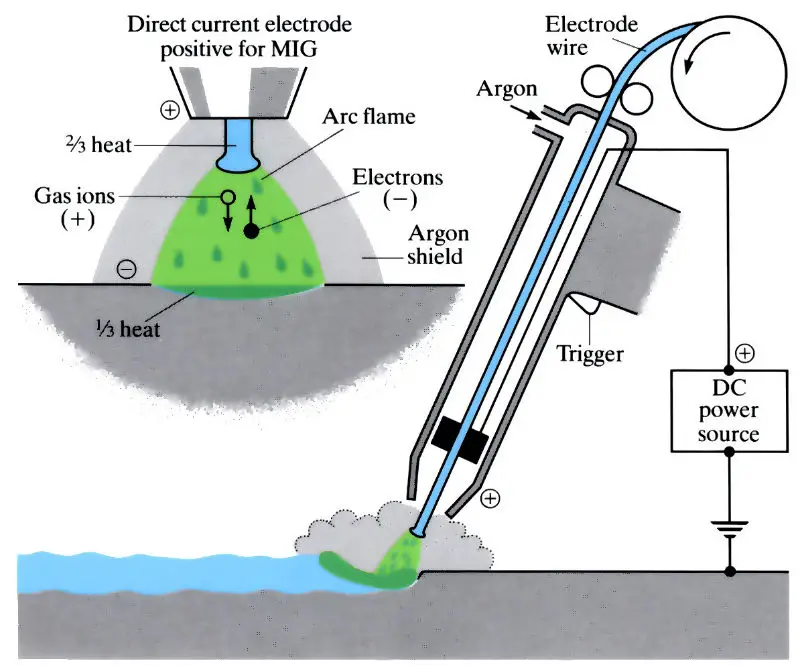Stick welding is also known as Shielded Metal Arc Welding (SMAW). The welding industry has embraced the phrase stick welding because the electrode that fuses the metal is in the shape of a stick.
Stick welding is a method of welding in which electricity is used to melt a metal filler electrode that melts both the metal joint and the electrode at the same time to unite two pieces of metal and fill the junction with filler metal.
Stick welding has certain distinct advantages. It is extremely adaptable, does not require the use of shielding gas, and is simple to conduct in windy and outdoor settings. It may also produce a somewhat lasting weld over a rusted or dirty surface, which might be useful in some instances.
What is a shielding gas?
Shielding gas serves several purposes, but the primary ones are to protect the weld pool from the environment and to provide a medium for the transfer of electricity from an electrode to a workpiece.
Even procedures that do not require an external gas supply, such as Manual Metal Arc Welding and Gasless Flux-cored Arc Welding, produce a shielding gas as a result of the breakdown of the flux in the presence of the welding arc.
The shielding gas can also affect arc stability, weld form, and penetration depth, as well as the mechanical characteristics and metallurgy of stainless steel weldments.
Shielding gases of various compositions are used in gas shielded procedures such as Gas Tungsten Arc Welding and Gas Metal Arc Welding depending on the application.
The stick welding method- why doesn’t it require shielding gas?
The ‘stick’ of stick welding is a fixed-length electrode covered in a powdered metal flux. When heated with electricity, the flux generates the shielding gas, while the melting electrode generates the filler material needed to form the weld with the base metal.
When the electrode tip makes contact with the metal surface, intense heat energy melts both the rod and the metal base, resulting in the weld.
As the flux coating vaporizes, a layer of gas and slag formed to shield the weld from contamination. After finishing the welding, the welder chips the slag off the weld bead.
As a result, there is no requirement for an external gas source, which is why stick welding is commonly used in remote and challenging situations.
Stick welding may be messy and create spatter, therefore there is typically some cleanup required. The overall outcome depends on the welder’s expertise, however stick welding rarely produces the most visually appealing welds.
Stick welding is not nearly as neat as other welding procedures. Molten spatter is a regular concern due to the way the weld works, therefore it must be considered in the welding workstation, and some sanding, cleaning, and finishing of the weld is usually necessary after work is completed – which can result in a longer total weld time and greater cost.
Furthermore, it is not nearly as time-efficient as other forms of welding. Weld cleaning, electrode switching, and other stages imply that you won’t be spending much time actually laying weld with stick welding.
Advantages of stick welding over other welding techniques that employ gas
Stick welding offers several benefits over mig welding (GMAW), flux-cored welding (FCAW), tig welding (GTAW), and sub arc welding (SAW).
Listed below are a handful of these benefits.
1. Low equipment cost- If compared to even the most basic MIG welders, SMAW requires incredibly simple and inexpensive equipment. Also, you don’t have to carry extra cylinders of gases for shielding the metal as stick welders do not employ gas.
2. Versatility and flexibility – If you need to weld multiple materials, as in maintenance welding, you may move from one kind to the other by changing simply the type of electrode you’re using, everything else remains the same.
Unlike MIG welding, which requires a gas change if you transition from carbon steel to stainless steel or aluminum, stick welding only involves reaching for the proper electrode and you’re good to go.
3. No shielding gas required- There is no need for shielding gas since SMAW electrodes create their own shielding gas (mostly carbon dioxide) when the arc burns off the coating. There’s no need to transport or fiddle with shielding gas cylinders.
4. Strong- The flux coating provides all of the alloying for stick electrode strength and arc characteristics.
Because alloying the flux is quite straightforward, stick electrodes capable of producing deposits with strengths of 120Ksi and higher are widely accessible.
5. Out-of-position welding – As the puddle hardens, slag is produced. This slag shields the molten puddle from the elements.
When we weld out of place, the slag functions as a shelf, supporting the puddle as it hardens. Stick welding is therefore an excellent alternative for welding vertically up or overhead.
6. Outdoor use- You cannot attempt MIG welding in the open air.
Reason?
Because even a 3mph (5kph) wind can blow away your shielding gas and cause porosity. Therefore, stick welding is useful in such situations because it may be done outside in gusts of up to 35 mph (58 kph).
Good reach- Because of their length, stick electrodes are more suited for welding difficult-to-reach parts (12-16 inches).
Disadvantages of Stick welding
To be fair, there are certain drawbacks too:
-
-
- Stick welding is a slow type of welding when compared to other methods.
- It is a more sophisticated operation that necessitates the use of a stick welder with ability and experience.
- It takes time to remove the slag that generated during the weld.
- Welding thinner metals can be tricky.
- Welding rods must be replaced more often in this sort of welding than in other types of welding.
- Stick welding can result in high spatter, rough surfaces, and porosity.
-
FAQs-
What are stick welding equipment?
Stick welding is the most basic of all electrical arc welding methods. A Stick Welder is made up of four parts:
-
-
- A power source with a constant voltage (CV) and a Stick Welder.
- Holder for electrodes or rods.
- Grounding clamp
- Welding electrodes/rods.
-
Applications of stick welding.
Stick welders are better suited for heavier metals and are not suitable for thin sheet metals.
They are ideal for structural steel fabrication, agricultural equipment maintenance, tractor repairs, ship building, power plant construction, welding pipe, and any metal 1/16 or thicker.
The following metals can be welded using stick method-
-
-
- Steel.
- Stainless steel
- Alloys based on nickel.
- Chrome.
- Stainless steel to ordinary steel.
- Aluminum (not the best choice but it does the job).
-
Conclusion
Stick welding is a simple technique when compared to other types of welding. There are substantial benefits of the shielded metal arc welding technique, but before you run out and buy a stick welder, bear in mind that it, like other welding procedures, has downsides and restrictions as well.
However, the main question is definitely answered. Stick welding does not require the use of an external shielding gas.
And we have included all that is necessary for you to know about stick welding.
Hope this helps!








